Copyright
©The Author(s) 2024.
World J Radiol. Nov 28, 2024; 16(11): 644-656
Published online Nov 28, 2024. doi: 10.4329/wjr.v16.i11.644
Published online Nov 28, 2024. doi: 10.4329/wjr.v16.i11.644
Figure 1 Pancreas volume measurement in a 62-year-old man with a normal pancreas, using portal venous contrast-enhanced computed tomography images.
A: Outline of pancreatic parenchyma was traced manually (green line) on each slice using a free region of interest (ROI) tool on contrast-enhanced-CT. While defining ROIs, care was taken to exclude the splenic artery and vein, superior mesenteric vein, and portal vein. The boundary of the pancreatic parenchyma was then outlined by extending the ROI using intensity-based semi-automated methods until the entire parenchyma in the slice was included; B: The traced pancreatic parenchyma was confirmed by the green area and manual correction was performed if misdelineation of the pancreatic borders was identified on axial, coronal, and sagittal images; C: The traced pancreatic parenchyma was transformed to the proximate shape in three dimensions and the pancreatic volume was then quantified. SpV: Splenic vein; PV: Portal vein; SMV: Superior mesenteric vein.
Figure 2 Scatter plot and regression curve.
A: Relationship between relative volume change of pancreas and follow-up period in all 33 patients with type-1 autoimmune pancreatitis. Mean relative volume change reduced exponentially and rapidly during the first 25 months of follow-up and then more slowly; B: Diffuse (D-) and mass-forming (M-) types resembled the overall regression curve. The regression curve was lower for patients with D-type compared with M-type autoimmune pancreatitis; C: Relative pancreatic volume change decreased gradually and slightly over time during long-term follow-up in 10 control subjects with normal pancreas.
Figure 3 Portal venous contrast-enhanced computed tomography images of 59-year-old man with diffuse-type autoimmune pancreatitis.
A: Initial computed tomography showing diffuse enlargement of the pancreas with capsule-like rim (arrowheads); B: One month later, pancreatic volume had decreased (relative volume change 683%) and capsule-like rim was observed; C: Six months later, pancreatic volume had decreased further (relative volume change 207%) and no capsule-like rim was observed; D-F: Relative volume changes after 12, 54 and 86 months were 224%, 21.5% and 20.6%, respectively.
Figure 4 Portal venous contrast enhanced-computed tomography images of a 60-year-old man with diffuse-type autoimmune pancreatitis and re-enlargement during follow-up.
A: Initial computed tomography showing diffuse enlargement of the pancreas with capsule-like rim (arrowheads); B: Three years later, pancreatic volume had markedly decreased (relative volume change 414%); C: Seven years later, re-enlargement (diffuse type) of the pancreas with capsule-like rim (arrowheads) was observed (relative volume change 575%); D: One year after re-enlargement, pancreatic volume had decreased again (relative volume change 241%; arrows).
Figure 5 Portal venous contrast-enhanced computed tomography images of a 67-year-old man with mass-forming type autoimmune pancreatitis and re-enlargement during follow-up.
A: Initial computed tomography showing enlarged pancreatic tail with capsule-like rim (arrowheads); B: Six months later, pancreatic volume had markedly decreased (relative volume change 598%); C: Four years later, re-enlargement of the pancreatic tail with no capsule-like rim (arrowheads) was observed (relative volume change 683%); D: One year after re-enlargement, pancreatic volume had decreased again (relative volume change 589%).
Figure 6 Cumulative re-enlargement rates during follow-up in patients with type-1 autoimmune pancreatitis.
A: Overall cumulative re-enlargement rates for all 33 patients at 1, 3, 5, 7 and 10 years of follow-up were 61%, 12.2%, 29.2%, 47.5% and 55.0%, respectively. The overall cumulative re-enlargement rates reached a plateau at 55% after 93 months (7.8 years); B: Cumulative re-enlargement rates were 133%, 13.3%, 29.4%, 52.3% and 64.7% in patients with diffuse-type (D-type) and 0%, 5.6%, 29.0%, 40.8% and 40.8% in patients with mass-forming type (M-type) autoimmune pancreatitis (AIP), and reached plateaus at 64.7% after 93 months (7.8 years) and at 40.8% after 77 months, respectively. Patients with D-type AIP showed lower cumulative re-enlargement rates than patients with M-type AIP, but the difference was not significant (P = 0.56).
- Citation: Shimada R, Yamada Y, Okamoto K, Murakami K, Motomura M, Takaki H, Fukuzawa K, Asayama Y. Pancreatic volume change using three dimensional-computed tomography volumetry and its relationships with diabetes on long-term follow-up in autoimmune pancreatitis. World J Radiol 2024; 16(11): 644-656
- URL: https://www.wjgnet.com/1949-8470/full/v16/i11/644.htm
- DOI: https://dx.doi.org/10.4329/wjr.v16.i11.644














